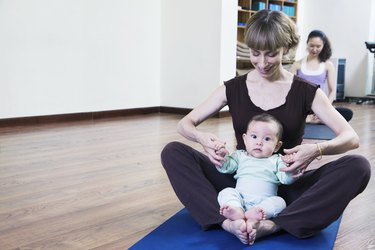
When a baby is born, she begins an exciting journey of reaching developmental milestones, including holding up her head, rolling over, sitting, crawling and walking. Not all babies develop at the same right, and different children will reach the same milestones at different ages. However, not meeting milestones can also be a sign of more complex developmental problems, so discuss your baby's progress with her pediatrician. Parents can help their children reach certain physical-development milestones by incorporating exercises developed by physical therapists, also known as physiotherapy; you should also discuss these with your child's pediatrician.
Tummy Time
Video of the Day
A baby will typically learn to sit up when he has developed the muscles in his neck and back, usually around the age of 4 to 6 months. The BabyCenter website recommends "tummy time" for babies from the time they are born. Because of the risk of sudden infant death syndrome (SIDS), doctors recommend that babies sleep on their backs, but during waking hours it is imperative that all babies spend time on their bellies. This develops the neck and back muscles crucial to for sitting up. Sitting next to your infant, place him on his stomach on the floor, making certain his face, mouth, and nose are not covered. You can also place baby on your stomach if he doesn't like being on the floor. Playing and talking with your baby while he is doing tummy time makes this exercise fun for both of you — but particularly for your baby.
Video of the Day
Props
From the time your baby is around 3 to 4 months old, you can begin propping her up in a sitting position. Sitting in a cross-legged position on the floor, place your baby on your lap while keeping them in a seated position. You can also use props to help your baby sit up with support. A nursing pillow — such as that sold by Boppy — in a basket supports your baby in sitting up, with the walls of the basket supporting the pillow and the C-shaped pillow supporting baby. While your baby will probably enjoy being in the basket, never leave her unattended.
Guided Exercises
To encourage good posture and continue to develop your baby's neck and back muscles, you can begin to help your baby sit up with a guided exercise. Start this around 3 to 4 months by placing your baby on his back and, holding his hands, pull him to a seated position. This will not only help strengthen the neck and back muscles, but will also help your baby develop proper posture as he works to keep his head in alignment with his body.
Reaching Exercises
Reaching for objects also develops the head, neck and back muscles you baby needs for sitting up and maintaining good posture. You can encourage this at any time by placing objects your baby loves to play with far enough away that she has to reach out and stretch to grab them. Place them close enough that your baby will not become discouraged trying to get them, but far enough away that she have to stretch her muscles to reach them, BabyCenter instructs. While your baby is sitting up in the pillow in a basket, you can place some age-appropriate toys in the basket to encourage reaching, too.